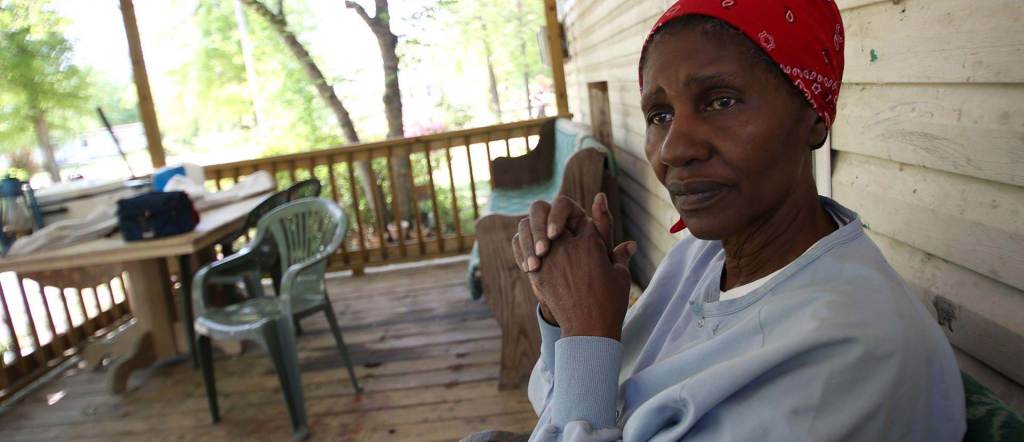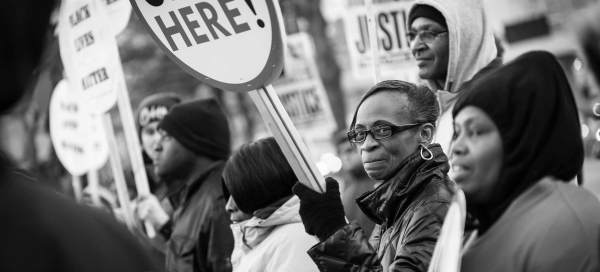
Approximately 50,000 people are still diagnosed with HIV in the United States every year. African Americans account for almost half of these diagnoses despite the fact that they only make up 12 percent of the population. Indeed, the HIV/AIDS crisis has taken root in black communities in the rural south. Southern states have the highest rates of new HIV diagnoses, the largest percentage of people living with the virus, and the most people dying from the disease. For black women living in the rural south, HIV/AIDS is one of the leading causes of death.
Against this backdrop, Wilhemina’s War (supported by JustFilms) depicts the devastating effects that stigma, discrimination, intergenerational poverty, and government and public health failures have had on the HIV epidemic and its impact on the black community in the south. In the movie, filmmaker June Cross tells the story of 62-year-old Wilhemina Dixon, a daughter of sharecroppers who lives in South Carolina with her daughter and granddaughter, both of whom are living with HIV.
Wilhemina picks peas and peanuts to support her family and serves as caregiver for her sick family members. And despite having no formal education, she teaches herself about public policy and becomes a forceful advocate for people living with HIV. Shot over the course of five years, the documentary highlights the resilience and determination of the human spirit in the face of tremendous adversity. Wilhemina’s War airs on PBS on February 29 and is available for free streaming on PBS.org. Ahead of the film’s television broadcast, we asked June Cross a few questions about her experience making the film, Wilhemina, her family and the impact of the HIV/AIDS epidemic on rural black communities in the south.
Andrew Catauro and Brook Kelly-Green: The film centers on the heroic efforts of Wilhemina and her granddaughter Dayshal to combat discrimination and the lack of information about HIV in their community. What is the importance of the individual actions undertaken by these two women to dispel misinformation regarding AIDS?
June Cross: Individual action is what keeps us from feeling hopeless. It is an expression of faith. Wilhemina and Dayshal are fighting a battle against stigma, isolation, lack of education and access to quality health care. Their actions increase awareness about the HIV epidemic in their community in South Carolina, and so hopefully some people go get tested, or change their behavior, or reach out and talk to someone about the isolation and depression they are feeling about having the disease.
The first step is to be willing to talk about the epidemic without judgment, and Wilhemina is a prime example of that. I have met “Wilheminas” living in all of the southern states. They toil, often unnoticed, in places where government is antagonistic, churches are agnostic, and families apathetic.
What are the systemic failures that have contributed the HIV/AIDS epidemic in southern states like South Carolina where Wilhemina lives?
As a region, the south has higher unemployment. Farming has failed, there’s little industry, and many live without health insurance or easy access to health care. There are state-run health clinics, but the history of the medical establishment’s tendency to use African-American patients as “lab rats” has left a legacy of suspicion and mistrust. At the federal level, the monies for HIV prevention, outreach, and treatment have been allocated mostly to the urban north. That has meant the states that most need the help now have the least among of federal dollars to work with. Congressional appropriations for those living with HIV have remained stagnant for the last eight years, while the numbers of people living with HIV continues to grow. Combine that with an education system that tends to teach abstinence-only education, and the stigma that continues to plague the LGBTQ community—which only gets reinforced in the Bible Belt— and you get a situation where the “Wilheminas” of the world are on their own.
In the film, we see AIDS activist Vivian Clark-Armstead talk about the recovery in New Orleans after Hurricane Katrina during a particularly stirring church service in South Carolina. Vivian tells parishioners that the government “ain’t coming” to help poor, rural South Carolinians out of the HIV crisis just as they had not in New Orleans. Having previously documented one family’s efforts to rebuild their home in the Lower Ninth Ward of New Orleans in The Old Man and the Storm, what similarities do you see in the political inaction around these two urgent and uniquely southern public health emergencies?
There is generally a reluctance to acknowledge public health as an interwoven set of circumstances, which are often beyond the ability of the individual to overcome. The south is in the realm of the Republican Party. And the realm is anti-government so those who lack the bootstraps to pull themselves up must get by as best as they can. In both Katrina and in the case of the HIV epidemic in the south, there is a lack of mental health support for those who need it. Such support is left to grassroots organizations, which are often underfunded and overworked.
Do you see efforts by social movements formed in response to state violence, like #BlackLivesMatter, as aligned with issues of state neglect (rural poverty, unequal access to health care, and poor education) that are portrayed in the film?
The recent alliance of the reproductive justice movement and the Black Lives Matter movement gives me hope in this regard. However, there is still an urban/rural, north/south, gay/straight, black/white dichotomy, which results from so many fighting for so few dollars to get the job done.
Are you still in contact with Wilhemina and Dayshal? If so, do you have an update on how they are doing?
Yes, I was just texting with Dayshal this morning. She dropped out of a GED program that she had been enrolled in because she said she couldn’t keep up with the class and didn’t have money for gas to get to and from class. I’m hoping the PBS broadcast of her story helps make a change in her life.
Wilhemina, who has been living with Hepatitis C for a long time, recently began the course of medications that will lead to her healing. She is currently doing well.
In the documentary, we also see the important work of grassroots groups like the South Carolina HIV/AIDS Council, which runs the only mobile testing van in the state. Where can people find out information about the organizations featured in the film?
The South Carolina HIV/AIDs Council just launched a new web site and it’s a great resource information. We also hope to continue to work with both the Positive Women’s Network and the AIDS Healthcare Foundation to do a series of regional screenings of the film in the south. The film will also be available for several months on PBS.org. Education is key so I encourage people to watch Wilhemina’s story.
Watch the trailer:
Accessibility Statement
- All videos produced by the Ford Foundation since 2020 include captions and downloadable transcripts. For videos where visuals require additional understanding, we offer audio-described versions.
- We are continuing to make videos produced prior to 2020 accessible.
- Videos from third-party sources (those not produced by the Ford Foundation) may not have captions, accessible transcripts, or audio descriptions.
- To improve accessibility beyond our site, we’ve created a free video accessibility WordPress plug-in.


